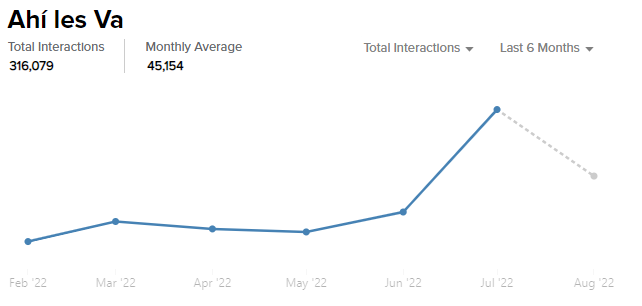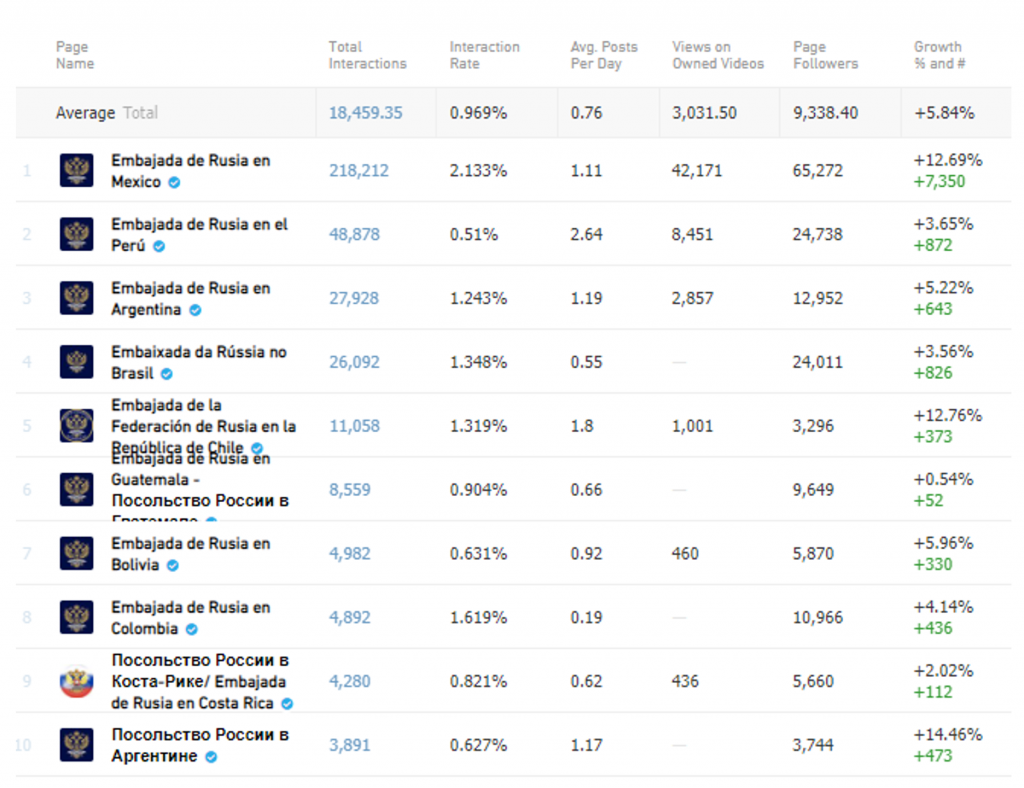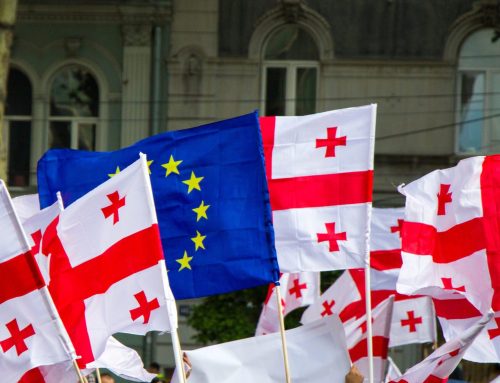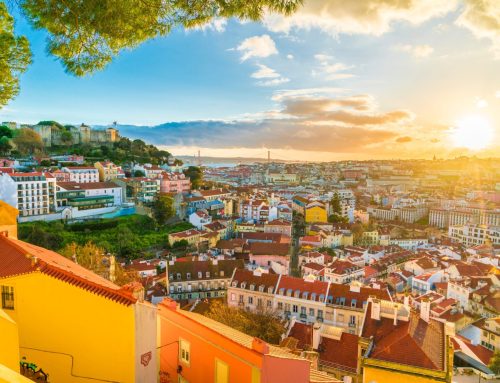Overview
Russia’s Spanish-language social media accounts have consistently punched above their weight, with follower numbers and engagement totals far outpacing those of Russia’s other external facing messengers. The success of Russia’s Spanish-language outlets has even drawn the attention of US lawmakers, who last month urged Meta, Twitter, and Telegram to crack down on Russian state media accounts targeting Spanish speakers in the Western Hemisphere. While Russia’s Spanish-language content remains popular, data collected on ASD’s Hamilton 2.0 tool and Facebook’s CrowdTangle tool show that some of Russia’s most influential Spanish-language accounts have been hit hard by platform restrictions. For these accounts, like RT en Español, initial engagement spikes at the start of the war have been followed by months of persistent decline. New media accounts and accounts for individual journalists have started to make up for that lost engagement, though, and Russia’s Spanish-speaking diplomats have seen significant growth. Some diplomats are now as visible on social media as state-backed outlets, raising questions about the efficacy of policies that treat state-funded media and state officials differently.
In the first 150 days of the war in Ukraine, Spanish-language tweets accounted for only 14 percent of all Russian posts monitored on Hamilton 2.0, but they generated 37 percent of the retweets and 25 percent of the likes. RT en Español’s account was by far the most influential of all accounts monitored on Hamilton2.0, earning 1.6 million retweets in the first 150 days of war—76 percent more than the next most popular account. Other Spanish-language accounts are also reaching broad audiences. Four of the ten most popular state media accounts and three of the ten most popular diplomatic accounts tweet primarily in Spanish. Individual Spanish-language posts are similarly dominant. Four of the five most retweeted posts by Russian state media accounts throughout the first 150 days of war were in Spanish. And Spanish-language accounts are putting in effort to get this kind of reach. Sputnik Mundo’s account, for example, more than doubled the number of tweets it posted through the first 150 days of the war compared to the same timeframe in 2021, and it earned more than 140 percent more retweets.

The five most retweeted Spanish-language posts by Kremlin-linked accounts between 2/24/22 – 7/23/22.
However, all the Twitter statistics on Russia’s Spanish-language media accounts are skewed by a massive spike in retweets and likes during the first month of the war. From February 24 to March 24, Russian Spanish-language state media and diplomatic accounts brought in more than a million retweets and nearly two million likes. The following month, retweets dropped by 38 percent and likes dropped by 37 percent. Every month since, Spanish-language accounts have drawn less engagement. This is likely the result of ephemeral interest in war-related content and Twitter’s policies to limit the reach of Russian state media on its platform.
RT en Español’s account has been hit particularly hard. In the first month of the war, it generated 612,943 retweets and 1,165,178 likes. Its engagements have dropped every month since. In the fifth month of the war, from June 24 to July 24, RT en Español’s retweets were down 72 percent and likes were down 70 percent compared to the first month of the invasion. The account’s numbers are also lagging significantly behind where they were in 2021. From June 24 to July 24, RT en Español’s retweets were down 49 percent and likes were down 61 percent compared to the same timeframe in 2021.

RT en Español’s Twitter metrics.
Despite that massive collapse, RT en Español remains the most influential Russian account tracked on Hamilton 2.0, and accounts affiliated with it are rising. The three fastest growing state media accounts in July were all associated with RT en Español. The account for its program Ahí les Va added 4,026 followers, making it the fastest growing media account. Ina Finogenova, who used to host Ahí les Va, saw the second biggest gain among state media accounts, followed by the RT en Español correspondent Helena Villar. Influential programs and journalists are filling the gap created by RT en Español’s waning popularity.
There was also significant and persistent growth on the diplomatic side. Russia’s Spanish-speaking diplomats sent 43 percent more tweets in the first 150 days of war compared to the same period in 2021—and those tweets generated 191 percent more retweets (from 150,130 to 436,949) and 152 percent more likes (from 316,730 to 799,519). The Spanish account for Russia’s Ministry of Foreign Affairs saw its retweets jump from 31,200 to 142,800. The Mexican Embassy’s retweets increased more than fourfold—from 26,500 to 113,700.

Most retweeted posts from Russian diplomats tweeting in Spanish between 2/24/22 and 7/23/22.
Unfortunately, issues with Facebook’s Crowdtangle data analysis tool made it difficult to determine the overall popularity of Russia’s Spanish-language content on the platform. ASD was unable to review statistics for RT en Español, which is generally the second most popular Russian state media page overall on Facebook (after RT Arabic) and by far the most popular Spanish-language Russian media page. However, the incomplete Crowdtangle data shows a decline in interactions with many Russian state media Spanish-language Facebook pages since the war began.
For example, Sputnik Mundo, which is typically the second most influential Spanish-language state media page, earned 887,767 total interactions during the first month of the war. The next month, that number fell to 386,271—a 56 percent drop. It has seen loses every month since then. During the fifth month of the war, from June 24 to July 24, its total interactions were down 75 percent from its first month high. For multiple months, it has earned fewer interactions than it did during the same timeframe in 2021.

Crowdtangle data showing Sputnik Mundo’s total engagements from February 2022 to July 2022.
Other pages also saw interactions drop sharply. Russia Beyond ES’ page earned only 301,805 total interactions in the first 150 days of war compared to more than 4 million total interactions during that same timeframe in 2021. RT Futuro, which posted more in the surveyed 2022 period than it did in 2021, still saw total engagements drop from 1,850,000 in 2021 to only 295,957 in 2022.
On the other side, the page for Ahí les Va, which became active three days before the war began and continues to operate without a state media label, has seen massive growth. During the first month of fighting, it brought in only 19,908 total interactions. By the fifth month, it was bringing in 80,553 total interactions.

Crowdtangle data showing Ahí les Va’s total engagements from February 2022 to July 2022.
Crowdtangle provided more complete data on Russian diplomatic pages, and, as with other platforms, diplomatic profiles have grown across the board since the war began. These pages averaged 18,459 total interactions in the first 150 days of war, which is more than double the amount they generated during the same period last year. Again, the Mexican Embassy enjoyed substantial growth, increasing its total interactions from 80,130 in the 2021 timeframe to 218,212 across the first 150 days of war. The Mexican Embassy’s page is now nearly on par with Sputnik Brasil, which had 291,065 interactions across the same 2022 period. Other pages, like the Embassy in Peru, also doubled their popularity but lagged well behind state media pages.

Crowdtangle data on the Russia’s Spanish-speaking diplomatic pages from 2/24/2022 to 7/23/2022.
What It Means
Data shows Russia’s Spanish-language accounts on Twitter and Facebook coming down from their early-war high but remaining as some of the Kremlin’s most powerful microphones. RT en Español is far and away Russia’s most influential Spanish-language Twitter account, earning millions of retweets and likes, but platform restrictions coupled with the public’s war fatigue have chipped away at the outlet’s popularity, as well as at the popularity of Russia’s Spanish-language media in general. Russian diplomats have not had similar issues. On both Twitter and Facebook, Russia’s Spanish-speaking diplomats have continued to build their reach. And as diplomats rise, state media accounts are working to get around platform restrictions, including by using alternative domains and by directing followers to new, unlabeled accounts, like Ahí les Va, and the accounts of state media personalities. Twitter, Facebook, and other platforms will need to keep pace with the Kremlin’s evolving propaganda tactics.
The views expressed in GMF publications and commentary are the views of the author alone.





